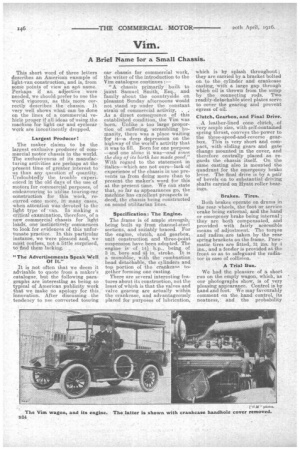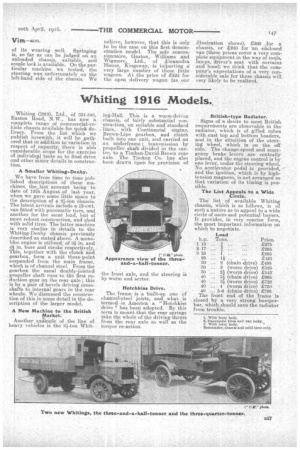Vim.
Page 4

Page 5

If you've noticed an error in this article please click here to report it so we can fix it.
A Brief Name for a Small Chassis.
This short word of three letters describes an American example of light-van construction, and is, from some points of view an apt name. Perhaps if an. adjective were needed,. we should prefer to use the word vigorous, as this more correctly describes the chassis. It very well shows what can be done on the lines of a commercial vehicle proper if all ideas of using the machine for light car and eyelecar work are incontinently dropped.
Largest Producer: The maker claims to be the largest exclusive producer of commercial motor chassis in the world. The exclusiveness of its manufacturing activities are perhaps at the present time of greater interest to us than any question of quantity. -Undoubtedly the trouble experi
enced in the old days of the use of motors for commercial purposes, of endeavouring to utilize touring-car construction for this work, recurred once more, in many cases, when attention was devoted to the light type of van. In making a critical examination, 'therefore, of a new commercial chassis for light loads, one instinctively commences to look for evidences of this unforL tunate practice. In this particular inStanee, we were pleased and, we must confess, not a little surprised,
tO find them lacking. .
"The Advertisements Speak Well Of It." .• It is not often that we deem it advisable to quote from a maker's catalogue, but the following. paragraphs are interesting as being so typical of American publicity work that we make no apology for this,, innovation. After discussing the tendency to use converted touring car chassis for commercial work, the writer of the introduction to the Vim catalogue continues :— " A chassis primarily built to jaunt Samuel Smith,Esq., and family about the countryside on pleasant Sunday afternoons would not stand up under the constant. strain of commercial activity. . . As a direct consequence .of this established condition, the Vim was born. Unlike a -too large proportion of suffering, -scrambling humanity, there was a place waiting for it=a deep depression on the highway of the world's activity that it was to fill. Born for one purpose —and one alone it was—and since the day of its birth has made good." With regard to the statement in italics—which are not ours—lack of experience of the chassis in use prevents us from doing more than to present the maker's word for this at the present time. We can state that, so far as appearances go, the machine has excellent prospects in deed, the chassis being constructed on sound utilitarian lines.
Specification: The Engine.
The frame is of ample strength; being built up froth channel-steel Sections, and suitably braced. For the. engine, clutch, and gearbox, unit construction and three-point suspension have been adopted. The engine is of 14:', h.p. being of 3. in, bore and 4i in. stroke. It is a anonobloc, with the combustion head detaChable, the ejlinders and top portion of the. crankcase together forming one casting.
There are several interesting features about its 'construction, not the leastof which is that the valves. and valve gearing are actually within the crankcase, and advantageously placed for purposes of lubrication,
which is by splash throughout; they are carried by a bracket bolted on to the cylinder and crankcase casting, with a large gap through which oil is thrown from the sump by the connecting rods. Two readily-detachable steel plates serve to cover the gearing and prevent egress of oil.
Clutch, Gearbox, and Final Drive.
A leather-lined cone clutch, of very ample size, with self-contained spring thrust, conveys the power to the three-speed-and-reverse gearbox. This is very short and com pact, with i sliding gears and gate change mounted n the cover, and therefore centrally. placed as regards the chassis itself. On the same casting also is mounted the quadrant for the emergency brake. lever. The final drive is by a pair of bevels on to substantial driving shafts carried on Hyatt roller bearings.
Brakes. Tires.
Both brakes operate on drums in the rear wheels, the foot or service , make being external, and the hand or emergency brake being internal ; they are both compensated, and provided with fairly aceessible means of adjustment. The torque and radius are taken by the rear spring brackets on the frame. Pneumatic tires are fitted, 31 ins. by 4 ins., and a fender is provided at the front so as to safeguard the radiator in case of collision.
A Trial Run.
We had the pleasure of a short run on the empty wagon, which, as our photographs show, is of very pleasing appearance. Control is by band and foot. -We may favourably comment on the hand control, its neatness,' and the probability of its wearing well. Springing is, so far as can be judged on an unloaded chassis, suitable, and ample lock is available. On the particular machine we tested, the steering was unfortunately on the left-hand side of the chassis. We oelieve, however, that this is only to be the case on this first demonstration model. The sole concessionnaire, Gaston, Williams and Wigmore, Ltd., of Alexandra House, Kingsway, is iraliorting very large number of these little wagons. At the price of £222 for the open delivery wagon (as, our illustration 'shows), £200 , for a chassis, or £240 for an eliclosed van (these prices cover a very complete equipment in the way of tools, lamps, driver's seat with curtains and hood) we think that the company's expectations of a very considerable sale for these chassis will very likely to be realized.






















